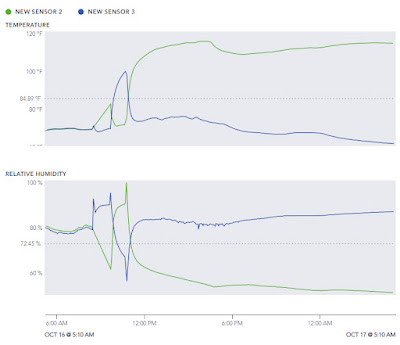... but it took a little effort to get it there.
The story so far: This is the second year I've grown my own tobacco. I don't smoke or chew, I just like to try various redneck projects. See this music video for more details. I'm a decent gardener, so growing it hasn't been a problem. Curing it hasn't been an issue, either. The rafters in my garage are a perfect place to dry the stuff after harvest. It's the fermentation, the process that removes ammonia from the leaves, that is such a problem. I've tried a couple of methods, all of which failed.
After many tries, I think I've got a fermenter that works. It's a plastic tote bin, appropriately in LSU purple, with a thermostat which controls a 40W bulb which, in turn, is suspended from the lid. The bin is wrapped in R13 insulation. A SensorPush hygrometer/thermometer supplies the data for me to check the status of the thing.
The wiring is simple. I've got a mechanical thermostat which closes the circuit whenever the temperature falls below a set level. I bought a cheap heat lamp from Home Depot and tore it apart to get to the 2-wire light bulb fixture. I didn't bother checking which wire was which, I just spliced my thermostat switch into one of them. Hey, man, it's AC, it's all good.
And that, as they say, was that. The SensorPush things gave me some trouble as their antenna patterns must be highly directional and plastic attenuates Bluetooth signals, but when I put their gateway close enough to the bin, it worked fine.
1 day of fermentation down, 20 or so more to go. The humidity needs some work, but I'm experimenting with that as well. This time, I won't spray water on the leaves directly as that led to mold in the past. Instead, I'll vary the surface area of a water reservoir in the bin to see if I can get to the desired 60%.
A Better Way To Get The Right Humidity
Instead of experimenting with the surface area of the container to get to the right humidity level, I'm just going to pour an ounce of water into the bottom of the fermenter until I get to the right level. The thought is that when the water spreads across the bottom, it should evaporate almost immediately, increasing the humidity level.
I found some calculations to figure out water weight vs volume by temperature to hit a specific humidity level, but they didn't make much sense given that my glass of water hasn't provided what should have been more than enough. Instead, I'll do this empirically. An ounce at a time ought to be sufficiently granular to find just the right amount.


2 comments:
OK, so here's the thing that I think is giving you problems with your humidity control: you are trying to do too many things with one device.
If your chamber is at equilibrium, and there is any standing water with an exposed surface, then it should be at 100% relative humidity inside the chamber. That is part of the definition of relative humidity. As long as there is exposed water, the only way to not have 100% humidity is to not have it be at equilibrium, which means that it unstable.
Adding more water surface inside your fermenter will make you approach equilibrium faster, but it will not actually change the equilibrium humidity level. Adding air circulation will also make you approach the equilibrium 100% humidity faster. Heating the air after it is no longer in contact with the liquid water will decrease the humidity, but only until the increased heat evaporates more water and brings it back to equilibrium.
I think what would simplify your life a great deal, would be for your humidifier to be a separate unit from your fermenter. You could have a chamber with a lot of water surface area, connected to your fermenter by a hose, with a fan that turns on and off depending on the humidity. When your humidity drops too low, it would bring in air from the separate humidifier. If the humidity becomes too high, you could switch to blowing in ambient San Diego air. And, if you vary the velocity of air flowing through your humidifier, you could have it provide air at whatever your target humidity is.
Excellent, as usual.
What you are saying without saying it is that the humidity measurements are suspect. Which is something you've indicated before - measuring humidity is a tricky business. I think I'll just assume that my humidity is fine, so long as I can see a little bit of standing water in the container.
Post a Comment